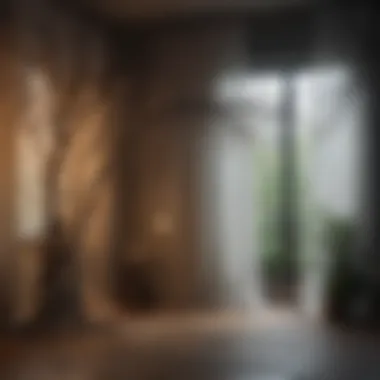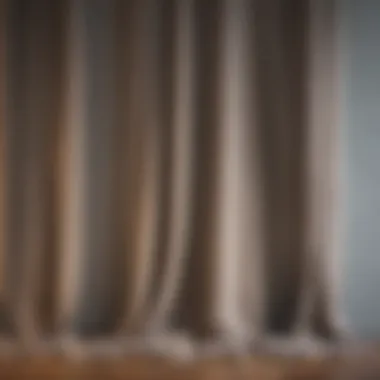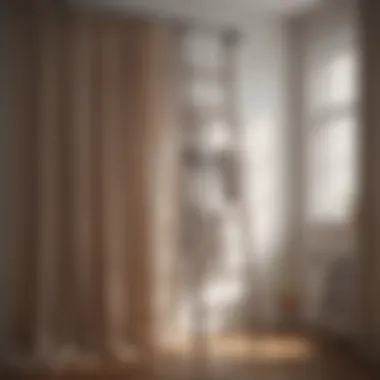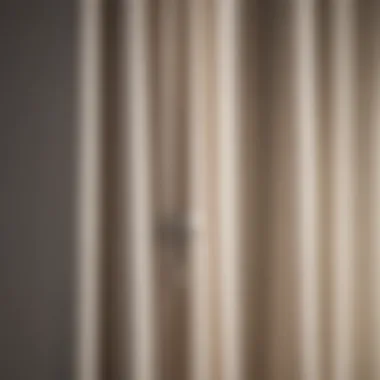Creative Ways to Hang Curtains Without Rods


Intro
Hanging curtains without a traditional rod opens up a realm of creative possibilities for any homeowner or interior design enthusiast. The techniques explored in this article highlight various methods that allow for unique and functional curtain displays. This guide delves into innovative approaches to elevate your interior spaces without relying on the conventional curtain rod. The objective is to inspire self-expression and provide practical solutions that not only meet aesthetic goals but also function well in your living environment.
Design Inspiration
Trending Styles
In recent years, unconventional curtain hanging methods have gained traction. Minimalist styles often embrace sheer fabrics hung with clips or magnetic systems, allowing for light diffusion without a bulky rod. Additionally, bohemian aesthetics favor natural materials like branches or driftwood. These elements bring texture and warmth, making the room feel inviting. For a modern touch, geometric designs utilizing metal brackets or rings can provide a sleek, contemporary look.
Color Palettes
Choosing the right colors for your curtains is essential. Soft neutrals can create a calming space, while vibrant hues can inject energy into a room. When selecting fabric, consider its impact on the overall color scheme. For example, deep greens or rich blues may complement a design focused on nature. Meanwhile, lighter shades offer fresher vibes, aligning with bright and airy interiors. Mixing patterns and textures can also enhance visual interest if done thoughtfully.
Practical Tips
Maintenance & Care
Curtains without rods can require specific care to maintain their beauty and functionality. It’s important to select materials that are easy to clean and maintain. Fabrics like polyester or blends are typically easy care, while natural fibers like cotton may need more frequent washing. Regularly check the hanging system for wear or looseness, especially with items like adhesive hooks or clips. Ensuring that systems are secure can prevent unexpected failures.
Budgeting & Planning
Every innovative project benefits from thoughtful planning. Determine your budget at the outset. Methods like using rope or wire can be cost-effective, while custom solutions may require more investment. Take time to measure your space and select materials that fit your overall design plan.
"The key to transforming a space often lies in the details. Rethinking how curtains are hung can lead to significant enhancements in style and function."
With proper planning and insight into styles and colors, hanging curtains without a rod can be both an exciting and rewarding endeavor.
Foreword
Hanging curtains without traditional curtain rods represents a significant shift in interior design practices. This article explores various innovative techniques that allow homeowners to enhance their living spaces, reflecting personal style while maintaining functionality. The traditional curtain rods often limit creativity and can be cumbersome in some home situations, creating a need for alternatives.
One key element to consider in this topic is the aesthetic flexibility provided by these alternative methods. They allow homeowners to explore diverse styles, from minimalist to bold artistic expressions. In addition, many modern solutions cater to specific installation challenges, such as those posed by windows in non-standard shapes or sizes.
The benefits of these approaches extend beyond mere aesthetics. By exploring different materials and installation techniques, homeowners can create unique atmospheres tailored for specific occasions, whether for family gatherings, cozy nights in, or lively parties. Furthermore, many of these options foster a sense of personal touch in home decor, a significant consideration for those who want their spaces to reflect individual tastes and personalities.
In an era where DIY culture is thriving, understanding the nuances of these innovative techniques empowers individuals to take control of their home design. Being informed about these methods can also lead to substantial cost savings compared to traditional installations. Consequently, this article aims to present a range of practical solutions, examining each method’s applicability and effectiveness in creating compelling window treatments.
Understanding the Need for Alternatives
Hanging curtains without traditional rods offers unique solutions that cater to diverse needs and aesthetic preferences. The simple act of choosing how to display curtains can influence not only the room’s appearance but also its functionality. Many homeowners find themselves looking for alternatives due to various factors such as architectural constraints, personal style, or practical considerations.
Limitations of Traditional Curtain Rods
Traditional curtain rods come with certain limitations. They can restrict creativity. If a window layout is not standard, finding a suitable rod that fits becomes problematic. Additionally, traditional rods often lack versatility in terms of style and materials. They may also limit the type of curtains that can be used, such as heavier drapery that requires sturdier support. Installation can be another barrier; not all walls are ready to accommodate rods due to material restrictions or structural issues. Finally, they can be costly, especially when purchasing additional hardware and installation tools.
Design Flexibility
Opting for alternatives opens up new avenues for design flexibility. Without a rod, one can use wall space in innovative ways. For instance, selecting various hanging methods allows for combining different curtain styles. This method can create unique visual accents. It also invites experimentation with textures and colors, which supports a more personalized design narrative. For those who appreciate minimalism, displaying fabric without visible hardware enhances the clean lines of a room.
Installation Challenges
Hanging curtains without rods addresses common installation challenges. Not all homes follow the same layout, and walls can vary in terms of material and condition. Alternatives often provide easier and less invasive solutions. Tools like adhesive hooks or tension systems eliminate the need for drilling. Such methods can be especially useful in rental properties where permanent alterations are not an option. This ease of setup also appeals to party hosts and homeowners who enjoy frequently changing their interiors.
As one contemplates these alternatives, it's important to recognize that each solution has potential advantages. Understanding these elements lays the groundwork for selecting the right method for hanging curtains.
The Aesthetic Appeal of No-Curtain-Rod Solutions
The decision to hang curtains without traditional rods can significantly influence the overall ambiance of a room. This transformative approach to window treatments not only supports functional needs but also allows for creative freedom. Homeowners and design enthusiasts alike can communicate their tastes and preferences through such innovative methods. Here are some key aspects that highlight the aesthetic appeal of no-curtain-rod solutions.


Minimalist Design Approach
A minimalist design philosophy emphasizes simplicity and functionality. By eschewing bulky curtain rods, spaces can feel more open and less cluttered. Smooth transitions from walls to windows can create an air of elegance. This approach aligns perfectly with contemporary aesthetic trends that favor less visual noise within living environments.
Moreover, achieving a clean look often allows other elements of the room, like furniture and decor, to shine. Without the distraction of traditional rods, the focus is on the fabrics and patterns of the curtains themselves. Light, airy materials can breathe life into a space, enhancing the overall aesthetic without demanding attention.
Unique Style Statements
No-curtain-rod solutions also offer unique opportunities for personal expression. From bold fabrics to unconventional hanging techniques, they encourage customization. Opting for vibrant materials or distinct patterns can draw the eye while allowing homeowners to reflect their individuality.
Using unconventional materials, such as rope or wire, can add character and make a statement about one’s style. Each method not only showcases creativity but also sets a tone for the room. Whether one prefers a rustic feel or a modern vibe, there are endless possibilities. By choosing to forego traditional rods, individuals can craft spaces that resonate with their identity while staying aligned with current trends.
"A thoughtfully designed space can nurture well-being and inspire creativity, especially when it reflects one’s personality."
The exploration of these aesthetic dimensions is essential in understanding how alternatives to traditional curtain rods can lead to improved interior design. Ultimately, the goal is to enrich one’s environment while matching personal style and functional requirements.
Alternative Techniques for Hanging Curtains
Exploring alternative techniques for hanging curtains without the conventional curtain rod offers a range of benefits. These methods not only embrace design creativity but also address practical concerns regarding installation, flexibility, and space. Homeowners and design enthusiasts often seek solutions that deviate from standard practices, aiming for a more personalized touch in their interior spaces. By understanding these techniques, individuals can make informed decisions that enhance both aesthetics and functionality in their homes.
Using Adhesive Hooks
Adhesive hooks present an efficient way to hang curtains without traditional fixtures. They come in various styles and sizes, making them suitable for different fabric types and weights. The application is simple: one needs to clean the surface to ensure the adhesive bonds well, peel off the protective backing, and firmly press it against the wall.
- Advantages:
- Considerations:
- No need for tools or drilling.
- Ideal for renters or temporary setups.
- Easy to remove without damaging the wall.
- Ensure the weight of the fabric does not exceed the hooks’ stated capacity.
- Choose a quality adhesive product to avoid future issues.
Clips and Grippers
Using clips and grippers can provide a unique way to hang curtains while allowing easy adjustments. These methods create a casual, unstructured look ideal for modern and eclectic decor styles. Clips can be attached to wall-mounted surfaces, through which a curtain can be hung.
- Pros:
- Cons:
- Versatile and customizable with different clip styles.
- Allows for easy swapping of curtains for different looks.
- May require additional mounting hardware depending on usage.
- Fixing the position can be less stable compared to rods.
Tension Rods and Hanging Systems
Tension rods are another innovative solution for hanging curtains without the need for fixed brackets or rods. They work by utilizing the pressure created by the rod itself, fitting snugly between two opposing surfaces.
- Benefits:
- Disadvantages:
- Easy setup and removal, making them suitable for smaller spaces such as bathrooms or closets.
- Can create layered looks with multiple curtains.
- Limited to lighter fabrics.
- Not suitable for very wide window frames without additional support.
Binder Clips and String Alternatives
Binder clips and string create an improvisational method to hang curtains. By attaching one side of the fabric with clips to a string stretched across a window, one can achieve a casual and creative window dressing.
- Advantages:
- Drawbacks:
- Inexpensive and readily available materials.
- Ideal for quick and temporary decor transitions.
- Can appear less sophisticated than traditional options.
- Requires regular adjustments depending on usage.


Velcro Strips for Temporary Solutions
Utilizing Velcro strips allows for a flexible, temporary solution to hanging curtains. By stitching or adhering one side of the Velcro to the fabric and the other to a wall or window frame, curtains can be easily installed and removed as desired.
- Pros:
- Cons:
- Quick and straightforward installation.
- Minimal wall damage compared to screws or nails.
- Not suitable for heavy drapery fabric.
- The adhesive may wear over time, requiring replacements.
Magnetic Curtain Solutions
Magnetic curtain solutions are another innovative method for seamless window coverage. These systems often come with magnets embedded within the fabric, adhering to metal surfaces or using magnetic strips on the wall.
- Benefits:
- Limitations:
- Provides a clean, modern appearance.
- Easy to open and close without the need for hardware.
- May need specific installation to work effectively on certain surfaces.
- Options can be limited in terms of curtain fabric style and pattern.
The exploration of these alternative techniques not only expands possibilities but also encourages creativity in decor. Whether seeking simplicity, cost-effectiveness, or aesthetic appeal, there is a method suited for various tastes and preferences.
Materials and Tools Required
In exploring ways to hang curtains without a traditional rod, it is essential to understand the materials and tools that are necessary for effective installation. The right choice of materials not only influences the aesthetics but also the functionality and durability of your curtain setup. Knowing what is available and how to work with different materials can empower homeowners and design enthusiasts to create versatile and personalized window treatments.
Types of Hooks and Fasteners
When it comes to hanging curtains without rods, hooks and fasteners are pivotal. There are various types of hooks that can be used to attach curtains to walls or other surfaces. Adhesive hooks are particularly popular because they offer ease of use without the need for drilling. They come in different weight capacities, so it is important to choose hooks that can support the fabric weight.
Other options include screw-in hooks, which provide a more permanent solution. They require a simple installation process but do involve tools like a drill or screwdriver. Clip hooks can also be effective, as they allow you to easily attach and remove fabric without damage. Opting for hooks that match your decor style, such as brushed nickel or vintage bronze, adds a decorative touch while serving a practical purpose.
Options for Fabric and Curtains
The type of fabric you choose can dramatically affect the overall appearance of your window treatment. Lightweight fabrics like sheer curtains can create a soft, airy effect, allowing light to filter through. Linen or cotton is also suitable for a casual look. If you desire a more dramatic effect, heavier fabrics like velvet or canvas can add warmth and richness to your space.
When purchasing or selecting fabric, consider the color and pattern. Solid colors may provide a more understated elegance, while bold patterns can make a strong statement. It's also wise to think about the curtain care; some fabrics are machine washable, while others may require dry cleaning, which adds to your maintenance considerations.
Support Structures
While hooks and fasteners serve as the primary means of hanging, additional support structures can enhance your curtain installation. Using a tension wire can be a clever solution for lightweight curtains. This thin wire can be strung across windows and secured at the ends, allowing for a curtain to be draped without any visible rods.
Alternatively, wooden dowels can be utilized as a more rustic option. They can be mounted on walls, and curtains can be slid over them, maintaining a natural look. One must consider the dimensions of the space when selecting a support structure to ensure that it complements the curtains while providing adequate support.
Planning the Installation
When undertaking the task of hanging curtains without a traditional curtain rod, proper planning is critical. This phase not only sets the foundation for a successful installation but also enhances the overall aesthetic and functionality of your window treatments. A well-thought-out installation process ensures that curtains fit well within the desired space and function effectively.
Measuring and Positioning
Accurate measurement is the first step in this planning stage. It involves deciding how high and wide you wish to hang your curtains. Here are some tips:
- Height: If you want to create an illusion of larger windows, consider hanging curtains closer to the ceiling. This draws the eye upward and enhances the room's height.
- Width: For fullness, measure the width of the window and multiply by 1.5 to 2 for the curtain length. This will help achieve a richer, more inviting appearance.
Correct positioning is equally essential. Mark the spots where you will place hooks or any other fixtures, ensuring they are level and symmetrically aligned. This provides a neat appearance that adds to the room’s decor.
Surface Preparation
Surface preparation is a necessary step that may often go overlooked. The walls where the curtains will hang must be clean, dry, and smooth to ensure any adhesive used will adhere properly. If using hooks that require drilling, check for any wires or pipes behind the wall to avoid damage. Clean the surface with a mild detergent to remove dust or grease. This will help ensure that any mounting or adhesive methods chosen will be durable and effective.


Proper planning prevents installation issues and ensures a visually appealing final look.
By focusing on these foundation elements of planning the installation, you create an environment where curtains can be hung effectively without the need for a traditional rod. Taking the time to measure carefully and prepare surfaces correctly can lead to a more successful and satisfying outcome.
Installation Techniques
Installation techniques are essential in any project that involves hanging curtains without a traditional curtain rod. These methods provide effective solutions that adapt to various aesthetics and functional needs. Understanding these techniques ensures a seamless installation process, maintaining the beauty and functionality of your window treatments.
Step-by-Step Guide to Using Adhesive Hooks
Adhesive hooks are a versatile option for hanging curtains without rods. They are easy to use and come in various designs, compatible with a range of curtain styles.
Here is a step-by-step guide to using adhesive hooks:
- Select the Right Hooks: Choose hooks designed to hold the weight of your curtains. Check weight limits on the packaging.
- Prepare the Surface: Clean the wall where you want to attach the hooks. Dry it thoroughly to ensure strong adhesion.
- Position the Hooks: Determine where you want to place your hooks. Use a level to align them correctly.
- Attach the Hooks: Remove the backing from the adhesive tape, press the hook firmly against the wall, and hold it for a few seconds.
- Hang the Curtains: Once the adhesive is secure, thread your curtains through the hooks. Adjust for even spacing.
- Final Adjustments: Step back and see if adjustments are needed for a balanced look.
Setting Up Tension Rods
Tension rods are another effective method for hanging curtains without a standard rod. They fit snugly between two surfaces, providing a minimalistic look without drilling holes.
To set up tension rods:
- Choose the Right Size: Measure the space where you want to install the rod to ensure a good fit.
- Prepare the Rod: Expand the tension rod according to your measurements.
- Position the Rod: Place the rod between two walls, or in a window frame, adjusting it until it is secure.
- Hang the Curtains: Slide the curtains onto the rod. Make sure they move freely.
- Test Stability: Gently pull on the curtains to ensure the rod is secure and holds the necessary weight.
Application of Velcro Strips
Velcro strips offer a creative and easy way to hang curtains. This method is especially useful for temporary setups or those who prefer a no-commitment approach.
Here’s how to apply Velcro strips:
- Buy Quality Velcro Strips: Select the appropriate width and adhesive type for your curtains.
- Prepare the Curtains: Attach one side of the Velcro strip to the top of your curtains using a sewing machine or fabric glue.
- Attach the Other Side to the Wall: Stick the matching Velcro strip to the wall where you want your curtains to hang.
- Press Securely: Firmly press the curtains against the wall, ensuring the Velcro adheres well.
- Adjust as Needed: If you need to remove or reposition the curtains, simply peel them off the wall and reattach.
Using innovative installation techniques allows for personalized and adaptable window treatments. These methods enhance aesthetic appeal without compromising functionality.
Maintenance and Care
Maintaining the integrity and appearance of curtains, particularly those not hung by traditional rods, is crucial for their longevity and functionality. The maintenance process entails various considerations, such as keeping the fabric clean and ensuring any adhesives or fasteners used remain effective over time. Understanding these aspects not only extends the lifespan of the curtains but also helps maintain the aesthetic appeal of your interior space.
Cleaning Fabric Options
The method of cleaning will vary depending on the fabric type of the curtains. Here are some common fabric types and their cleaning requirements:
- Cotton: This is a popular option for curtains due to its breathability. Cotton curtains can be machine washed on a gentle cycle, using cold water to prevent shrinking.
- Polyester: Known for its durability, polyester curtains can often be machine washed as well. A low-temperature setting is advisable to maintain the fabric's texture and color.
- Silk: Requires more delicate care. These curtains should be dry cleaned only to prevent damage.
In addition, dust accumulation is inevitable. Regular dusting or a gentle vacuuming can prevent dirt buildup. For more stubborn stains, a soft cloth with a mild detergent should be employed. Keeping curtains clean enhances their overall appearance and ensures they contribute positively to the room’s atmosphere.
Checking Adhesives and Fasteners
The sustainability of the curtain-hanging methods depends significantly on the quality of the adhesives and fasteners involved. Regular checks should be performed to ensure everything remains secure.
- Adhesive Hooks: These should be inspected periodically for signs of weakening or peeling away from the surface. If found compromised, they should be replaced immediately to avoid curtains falling unexpectedly.
- Velcro Strips: If used, ensure they maintain their grip. Exposure to humidity may affect adhesion over time, so testing them regularly is essential.
Regular maintenance is critical to ensure that alternative hanging methods do not compromise safety or the aesthetics of your living space.
Finale
The conclusion section serves as a pivotal element in any article. In the context of this piece, it summarizes the key points discussed regarding innovative techniques for hanging curtains without a traditional rod. The importance of this topic lies in its ability to provide homeowners and interior design enthusiasts with practical and creative solutions.
One benefit of these alternative methods is their flexibility in design. Homeowners often seek ways to express their personal style, and by using innovative techniques, they can easily change or adapt their window treatments. This adaptability not only enhances the overall aesthetic of a space but also allows for unique design expressions that are not confined to conventional methods.
Another consideration is functionality. Each method discussed in the article offers different levels of installation ease, maintenance care, and durability. For instance, using adhesive hooks or Velcro strips may appeal to those who prefer temporary solutions. On the other hand, tension rods and magnetic systems provide sturdier options that may be better suited for heavier fabrics.
From a practical standpoint, understanding the variety of materials and tools available empowers homeowners to make informed decisions. Knowledge of specific techniques and their applications can transform a standard room into a personalized sanctuary, reflecting individual tastes and lifestyles.
In this evolving landscape of interior design, the emphasis on creativity and self-expression continues to grow. This article highlights the significance of thinking beyond traditional curtain rods, encouraging readers to explore the extensive possibilities that lie within alternative options. As they consider applying these methods, homeowners may find themselves not just enhancing their living spaces, but also redefining how they perceive and implement décor throughout their homes.















